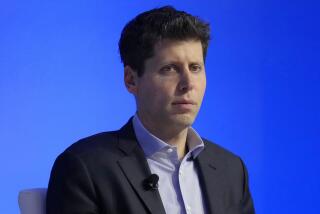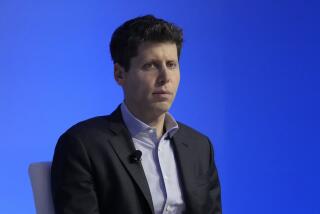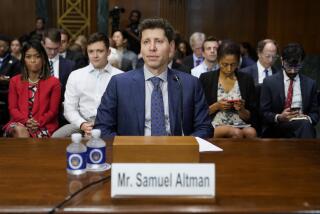AMI Chairman Resigns, Is Replaced by Harry J. Gray
- Share via
Richard Gilleland, in a surprise move, resigned Thursday as chairman of American Medical International and has been succeeded by former United Technologies Chairman Harry J. Gray, an AMI director.
Gray was expected to wield great influence at AMI when he joined the board after engineering the $1.67-billion buyout last month of the Beverly Hills hospital chain. However, IMA Acquisition Corp., jointly owned by Gray and First Boston, had planned to retain Gilleland. And in comments late last month, Gilleland expressed a willingness to remain in the top spot.
The unexpected change has prompted observers of the health-care industry to speculate about the extent of plans to sell AMI assets. The development also is just the latest controversy over management control involving Gray, a hard-driving executive who impressed much of the corporate world by assembling the companies that form United Technologies.
Gray and Gilleland, whose contract called for a $4-million payment if he left the firm in the event of a takeover, declined to comment. John Harrison, a First Boston managing director and an AMI director, said the changes were the result of a “mutual agreement” involving Gilleland and AMI’s board. The board elected James Lyons, a principal in Harry Gray, Mel Klein & Partners, as president of AMI.
“We think it’s a good decision,” said Harrison, who declined to give details on developments leading to the changes. “What is needed is a strong sense of leadership and a general business background, and Harry Gray and Jim (Lyons) have that.”
The unexpected leadership change has prompted industry analysts to raise questions about AMI’s future. AMI has 11 of its 50 U.S. hospitals in California and 23 facilities abroad. Harrison said Gray intends to offset the acquisition costs by carrying out a strategy announced by Gilleland last month that calls for the sale of all foreign properties and some domestic hospitals.
However, some Wall Street analysts assume that Gray took control to sell all of AMI’s assets--foreign and domestic.
“They’re going to break up the company,” said Seth Shaw, an analyst in the New York offices of Prudential-Bache Securities.
However, Shaw said that in any mass selloff, the new owners would have difficulty recouping their costs.
“There are going to be a lot of assets for sale, but as Neal Sedaka said--’breaking up is hard to do.’ They bought this company at too high a price and it will be difficult to recoup (the costs) because there aren’t that many buyers out there.”
Other analysts think that Gray plans to retain some of the domestic hospitals.
“I have to believe they’ll stay with that strategy if they indicate support for the plan,” said John Hindelong, an analyst at New York-based Donaldson Lufkin & Jenrette. “Whoever runs this company has a lot of work to do. Given Gray’s experience and track record, I’m sure he realizes what he has bitten off.”
Hindelong said Gilleland may have resigned because Gray, who was chairman of United Technologies for 14 years, may have demanded too large a decision-making role as an AMI director.
“I’m surprised this (change) occurred but it might have been predicted,” Hindelong said. “There are strong-willed people in the buyout group, and Dick Gilleland is strong willed. If you think about it, the change shouldn’t be a shock.”
After joining United Technologies in 1971, Gray became the company’s chief executive a year later and began a series of takeovers that would make him the master acquirer of the 1970s: Essex International, Otis Elevator, Carrier and Mostek.
However, some former associates at United Technologies say Gray did not easily share decision-making authority and that he was reluctant to groom a successor. In fact, four men who might have succeeded him as chairman either quit or were forced out. Finally, in 1984--when Gray was nearing the mandatory retirement age of 65--the board of United Technologies began to pressure Gray to choose a successor, said Olcott D. Smith, a former director at the company.
“We had to shake him up,” said Smith, who retired from the United Technologies board in 1986. “We told him, ‘Harry, we have to have a candidate. Many chief executives don’t like to leave. I think he would have preferred to stay because he did a good job.”
Smith, former chairman of Aetna Life & Casualty Co., said Gray has the capacity to quickly learn the nuances of the health-care industry. Gray retired from United Technologies in 1986.
Unlike the 69-year-old Gray, Gilleland made his reputation in the health-care industry. Gilleland, 45, joined AMI as chairman and chief executive last January after steering the turnaround of a Texas health-care firm.
Gilleland was expected to accelerate a financial recovery at AMI. Burdened by debt and squeezed by cost cutting in the Medicare program, AMI lost $97.3 million in the fiscal year ended Aug. 31, 1986. Unsatisfied at the pace of financial recovery, major AMI shareholders had pressured Gilleland’s predecessor, Walter Weisman, to resign in 1988.
More to Read
Inside the business of entertainment
The Wide Shot brings you news, analysis and insights on everything from streaming wars to production — and what it all means for the future.
You may occasionally receive promotional content from the Los Angeles Times.










